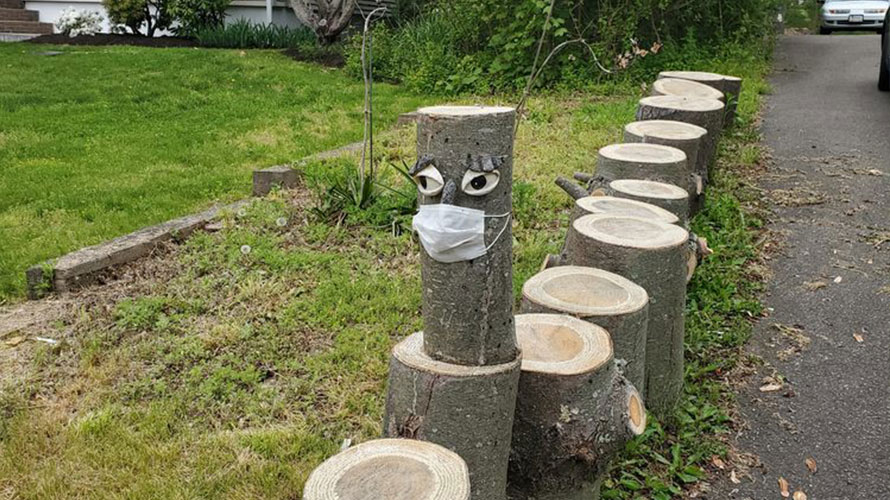You’re worried your tree might be getting sick, and you want to catch problems early. Smart move. The sooner you spot trouble, the easier it is to help the tree and avoid bigger costs later.
Here are the signs to look for:
- Watch for sudden leaf changes (spots, yellowing, early drop).
- Check bark and trunk for cracks, oozing, or mushrooms.
- Look for dead tips or thinning in the crown.
- Scan roots and base for soft wood or fungal growth.
- Notice pests (boring holes, sawdust, sticky residue).
In this guide, we’ll show you simple checks you can do in minutes, how to read common symptoms, and what to do next. We’ll also share a quick reference table so you know when to call a pro.
Start with a quick, top-to-bottom scan (takes 2 minutes)
Stand back and look at the whole tree. Is the crown even and full, or thin on one side?
Walk around the tree. Compare it to nearby trees of the same kind. If yours looks weaker or drops leaves earlier, that’s a red flag.
Quick Tip: Take a photo today from the same spot you’ll use in the future. Comparing photos makes slow changes obvious.
Leaves: the earliest warning signs
Healthy leaves look consistent across the tree. Patchy color or random bare sections can point to disease.
Watch for spots, yellowing between veins, curling, or a white/gray powder (mildew). Early leaf drop in midsummer is a tell.
Info: Weather can mimic disease. Heat, drought, or late frost can stress leaves. If symptoms follow extreme weather, give it a week or two and water properly before assuming disease.
Branches and twigs: tip dieback and brittle wood
Look for dead tips that snap easily, or small twigs without buds. Check for “flagging”—one branch turning brown while others stay green.
Dieback that moves inward often means root or vascular trouble. If pruning reveals brown, dry inner wood where it should be creamy and moist, that’s a concern.
Bark and trunk: cracks, cankers, and ooze
Scan the trunk for sunken patches (cankers), bleeding sap, or dark streaking. Peeling bark or new cracks can signal infection or internal decay.
See mushrooms or shelf fungi on the trunk? That often indicates wood decay inside, not just surface growth.
Danger: Large mushrooms or shelf fungi on the trunk or root flare can mean structural weakness. Keep people and cars away until the tree is assessed.
Roots and base: look where problems often start
The root flare (where the trunk widens at ground level) should be visible, not buried. Soil piled against the trunk traps moisture and invites disease.
Check for soft, punky wood, sour smells, or mushrooms at the base. Heaving soil or leaning after storms can mean root failure.
Pests or disease? Clues to tell them apart
Pests leave holes, sawdust, sticky honeydew, webbing, or tiny exit holes. Disease tends to show leaf spots, cankers, and dieback without sawdust.
Sometimes both occur: pests attack a stressed, diseased tree. If you see attack patterns plus leaf or bark symptoms, treat the stress first and address pests second.
Fact: Many serious tree diseases spread through water-moving tissue (xylem/phloem). That’s why you see whole-branch wilting or one-sided decline.
Quick symptom guide
Use this table as a fast way to narrow down what you’re seeing. It won’t diagnose every issue, but it points you in the right direction.
| Symptom you see | What it might mean | What to do first |
| Leaves with round spots and early drop | Fungal leaf spot | Rake and bin leaves; improve airflow; avoid wetting leaves |
| One branch suddenly wilts | Vascular wilt or borer damage | Prune and dispose of the affected branch; sanitize tools |
| White powder on leaves | Powdery mildew | Improve sun/airflow; avoid overhead watering; prune lightly |
| Mushrooms at the base | Root or trunk decay | Keep distance; call a certified arborist |
| Oozing dark sap on the trunk | Canker or stress injury | Reduce stress; avoid wounding; consult a pro if spreading |
| Tiny holes + sawdust (frass) | Wood-boring insects | Prune affected wood; strengthen tree health; pro treatment may be needed |
Simple weekly check routine (spring through fall)
Pick one day each week. Walk around the tree, looking at leaves, branches, bark, and the base. Use your phone to note changes.
Water deeply during dry spells, and mulch 2–3 inches thick—pulled back from the trunk. Healthy trees resist disease better.
Warning: Don’t pile mulch against the trunk. “Volcano mulching” traps moisture and can lead to rot and pests.
Common red flags you should never ignore
- Mushrooms on the trunk or at the base.
- A new lean after storms or cracking soil around roots.
- Large dead sections in the crown.
- Oozing cankers or peeling bark are spreading each month.
If you see any of these, bring in a certified arborist soon.
How to keep the disease from spreading to other trees
Clean up and bin fallen leaves and pruned wood. Don’t compost diseased material.
Sanitize tools between trees. Water the soil level to keep leaves dry. Space new plantings for good airflow.
Prevention checklist:
• Clean debris and sanitize tools.
• Water deeply, not often.
• Keep mulch off the trunk.
• Prune lightly and correctly.
• Act fast on red flags.
Conclusion
Catching disease early is all about simple, repeatable checks: leaves, branches, bark, and roots. Compare your tree to its healthy self and its neighbors, and trust what changes over time.
If you see mushrooms on the trunk, serious dieback, or a new lean, get help quickly. For a professional tree health assessment and safe treatment options, consider New View Tree Care.

